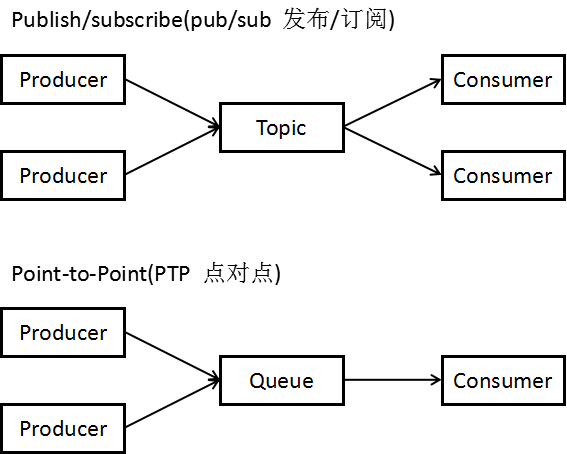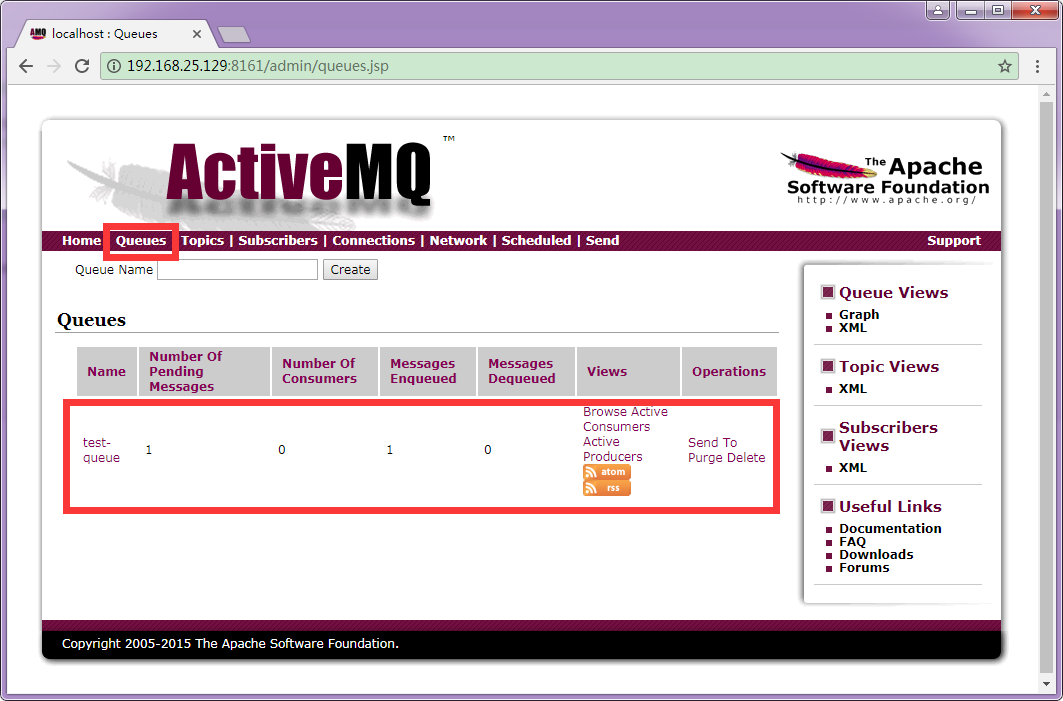一、添加 jar 包
<dependency> <groupId>org.apache.activemq</groupId> <artifactId>activemq-all</artifactId> <version>5.11.2</version> </dependency>
二、消息传递的两种形式
1、点对点:发送的消息只能被一个消费者接收,第一个消费者接收后,消息没了
2、发布/订阅:消息可以被多个消费者接收 。发完消息,如果没有消费者接收,这消息会自动消失。也就是说,消费者服务必须是启动的状态。( topic 消息在 ActiveMQ 服务端默认不是持久化的,可以通过配置文件配置持久化 )

三、点对点发送消息
/** * 点到点形式发送消息 * @throws Exception */ @Test public void testQueueProducer() throws Exception{ //1、创建一个连接工厂,需要指定服务的 ip 和端口 String brokerURL = "tcp://192.168.25.129:61616"; ConnectionFactory connectionFactory = new ActiveMQConnectionFactory(brokerURL); //2、使用工厂对象创建一个 Connection 对象 Connection connection = connectionFactory.createConnection(); //3、开启连接,调用 Connection 对象的 start 方法 connection.start(); //4、创建一个 Session 对象。 //第一个参数:是否开启事务(一般不开启,如果开启事务,第二个参数没意义); //第二个参数:应答模式。自动应答或者手动应答,一般是自动应答 Session session = connection.createSession(false, Session.AUTO_ACKNOWLEDGE); //5、使用 Session 对象创建一个 Destination 对象。两种形式 queue、topic。 Queue queue = session.createQueue("test-queue"); //6、使用 Session 对象创建一个 Producer 对象 MessageProducer producer = session.createProducer(queue); //7、创建一个 Message 对象,可以使用 TextMessage。下面两种方式都可以 /*TextMessage textMessage = new ActiveMQTextMessage(); textMessage.setText("hello ActiveMQ");*/ TextMessage textMessage = session.createTextMessage("hello ActiveMQ"); //8、发布消息 producer.send(textMessage); //9、关闭资源 producer.close(); session.close(); connection.close(); }

四、点对点接收消息
/** * 点对点接收消息 * @throws Exception */ @Test public void testQueueConsumer() throws Exception{ //1、创建一个 ConnectionFactory 对象连接 MQ 服务器 String brokerURL = "tcp://192.168.25.129:61616"; ConnectionFactory connectionFactory = new ActiveMQConnectionFactory(brokerURL); //2、创建一个连接对象 Connection connection = connectionFactory.createConnection(); //3、开启连接 connection.start(); //4、使用 Connection 对象 创建一个 Session 对象 Session session = connection.createSession(false, Session.AUTO_ACKNOWLEDGE); //5、创建一个 Destination 对象。queue 对象 Queue queue = session.createQueue("test-queue"); //6、使用 Session 对象创建一个消费者 MessageConsumer consumer = session.createConsumer(queue); //7、接收消息 consumer.setMessageListener(new MessageListener() { @Override public void onMessage(Message message) { //8、打印结果 TextMessage textMessage = (TextMessage) message; try { String text = textMessage.getText(); System.out.println(text); } catch (JMSException e) { // TODO Auto-generated catch block e.printStackTrace(); } } }); //9、等待接收消息。( 接收到消息后才网下面执行。关闭资源 ) System.in.read(); //10、关闭资源 consumer.close(); session.close(); connection.close(); }
五、广播发送消息
/** * 广播发送消息 * @throws Exception */ @Test public void testTopicProducer() throws Exception{ //1、创建一个连接工厂,需要指定服务的 ip 和端口 String brokerURL = "tcp://192.168.25.129:61616"; ConnectionFactory connectionFactory = new ActiveMQConnectionFactory(brokerURL); //2、使用工厂对象创建一个 Connection 对象 Connection connection = connectionFactory.createConnection(); //3、开启连接,调用 Connection 对象的 start 方法 connection.start(); //4、创建一个 Session 对象。 //第一个参数:是否开启事务(一般不开启,如果开启事务,第二个参数没意义); //第二个参数:应答模式。自动应答或者手动应答,一般是自动应答 Session session = connection.createSession(false, Session.AUTO_ACKNOWLEDGE); //5、使用 Session 对象创建一个 Destination 对象。两种形式 queue、topic。 Topic topic = session.createTopic("test-topic"); //6、使用 Session 对象创建一个 Producer 对象 MessageProducer producer = session.createProducer(topic); //7、创建一个 Message 对象,可以使用 TextMessage。下面两种方式都可以 /*TextMessage textMessage = new ActiveMQTextMessage(); textMessage.setText("hello ActiveMQ");*/ TextMessage textMessage = session.createTextMessage("hello ActiveMQ"); //8、发布消息 producer.send(textMessage); //9、关闭资源 producer.close(); session.close(); connection.close(); }

六、广播接收消息
/** * 广播接收消息 * @throws Exception */ @Test public void testTopicConsumer() throws Exception{ //1、创建一个 ConnectionFactory 对象连接 MQ 服务器 String brokerURL = "tcp://192.168.25.129:61616"; ConnectionFactory connectionFactory = new ActiveMQConnectionFactory(brokerURL); //2、创建一个连接对象 Connection connection = connectionFactory.createConnection(); //3、开启连接 connection.start(); //4、使用 Connection 对象 创建一个 Session 对象 Session session = connection.createSession(false, Session.AUTO_ACKNOWLEDGE); //5、创建一个 Destination 对象。Topic 对象 Topic topic = session.createTopic("test-topic"); //6、使用 Session 对象创建一个消费者 MessageConsumer consumer = session.createConsumer(topic); //7、接收消息 consumer.setMessageListener(new MessageListener() { @Override public void onMessage(Message message) { //8、打印结果 TextMessage textMessage = (TextMessage) message; try { String text = textMessage.getText(); System.out.println(text); } catch (JMSException e) { // TODO Auto-generated catch block e.printStackTrace(); } } }); System.out.println("topic消费者"); //9、等待接收消息。( 接收到消息后才网下面执行。关闭资源 ) System.in.read(); //10、关闭资源 consumer.close(); session.close(); connection.close(); }